Is there a mirror image for Occam’s Razor? Seems like if we have a name for relying on the least complex explanation for a scenario, then we ought to have one for the most outlandish, unlikely, logic-defying explanation. For instance, recently we got engine data for a Cessna TR182 Turbo Skylane RG. The shop replaced a failed CHT probe and all of a sudden that cylinder’s CHTs were about 100º hotter. EGT’s hadn’t changed so the problem seemed to be cooling related.
We recommended checking baffles and – although no exhaust maintenance had been performed – checking for an exhaust leak. After coming up empty checking all the logical explanations, somebody at the shop noticed that the new CHT probe in cylinder 3 didn’t look like its neighbors in cylinders 1 and 5. Installing the wrong probe gave us bad data and a pretty good goose chase. And something to consider next time we see that scenario.
Let’s take a closer look at the data from the Turbo Skylane. The engine is a Lycoming O-540 and data is from a JPI 830 with a 1 sec sample rate. EGTs on top, with CHTs and FF below.
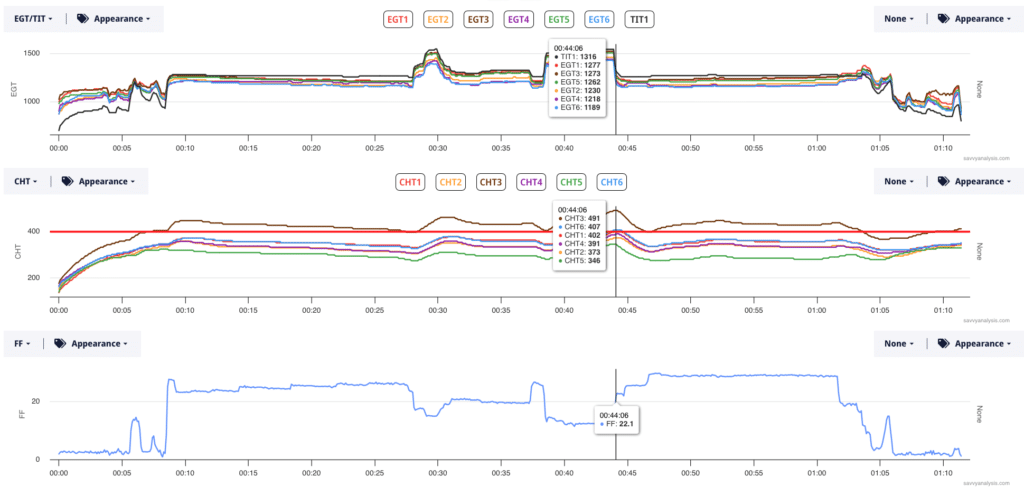
Max CHT is 491 – just 9º shy of Lycoming’s never-exceed temp. We know now that this is bogus, but the pilot didn’t know it in real time. Let’s give credit for the big FF increase at 45 mins that brings CHT 3 down almost 100º.
As far as analysis, we noticed the heating pattern for the first 5 mins was very different for CHT 3, but that’s consistent with an exhaust leak. Honestly, installing the wrong probe wasn’t on our bingo card. It is now.
If you want more, Google CHT probes J and K.
Next is data from a Beech Bonanza 36 powered by a Continental IO-500 and data from a Garmin G1000 with a 1 sec sample rate. Here’s a test profile flight with mixture sweeps and a mag check at the 45 min mark. EGTs on top, then CHTs, and FF and RPMs below.
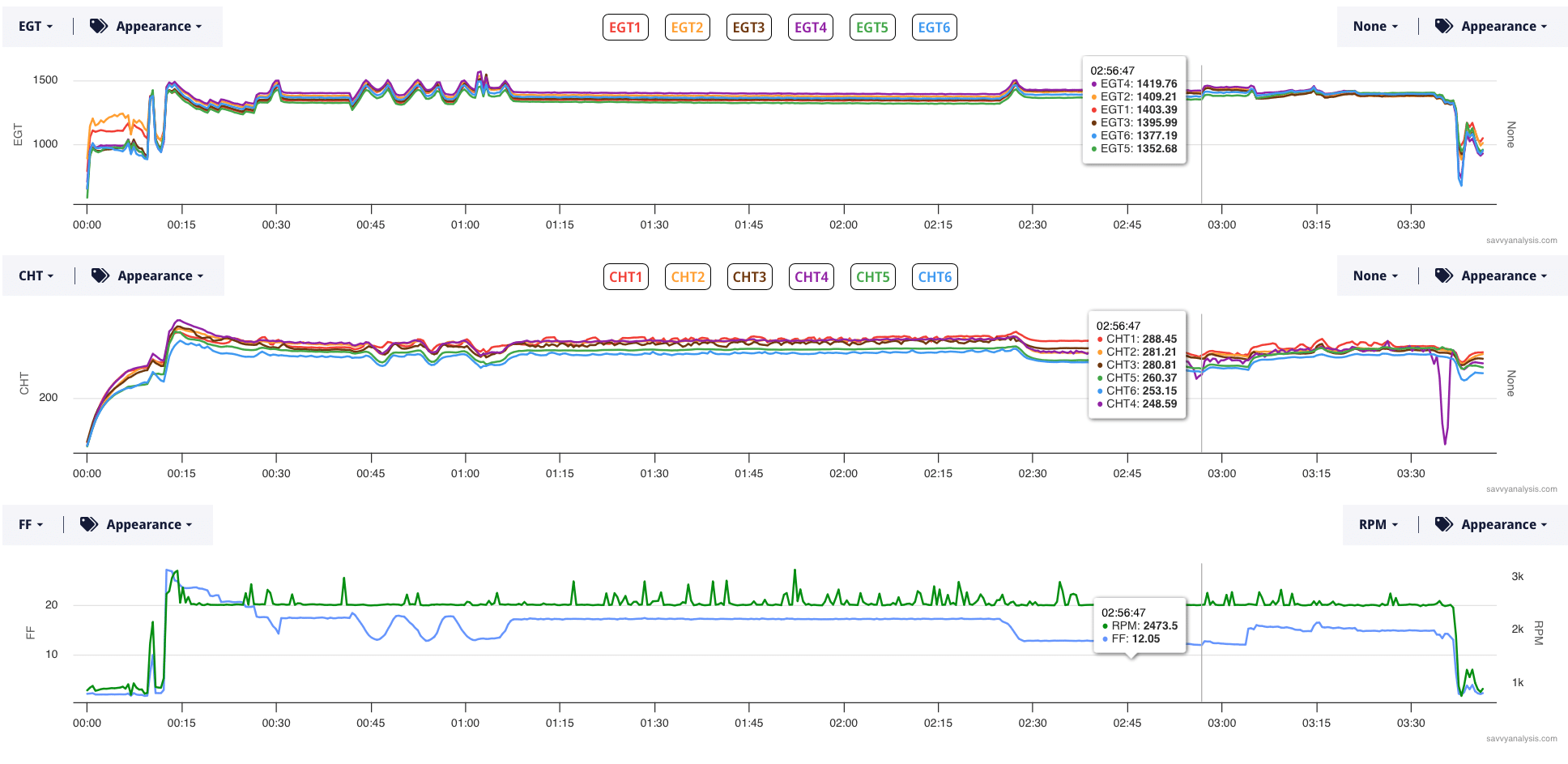
Those spikes in RPM are troubling – if they’re real. Redline is 2700 and there are spikes to over 3100 in the data. We’re not seeing any corroboration in the EGT, CHT or FF data. If the pitch of the prop is really changing that much maybe it’ll be corroborated by changes oil pressure. Let’s take a look at RPMs and oil pressure.

Not a peep from oil pressure, and the client didn’t report surging or engine roughness. Typical with a loose connection we would see data dropping out and spikes to the low side. It always makes sense to check the connection first, but these spikes to the high side – every single one – are more likely signaling a failing RPM sensor.
Next is data from a Cirrus SR 22T powered by a Continental TSIO – 550 data from a Garmin Perspective with a 1 sec sample rate. This is a test profile flight, with a mag check at the 45 minute mark and a set of mixture sweeps about a half hour later.
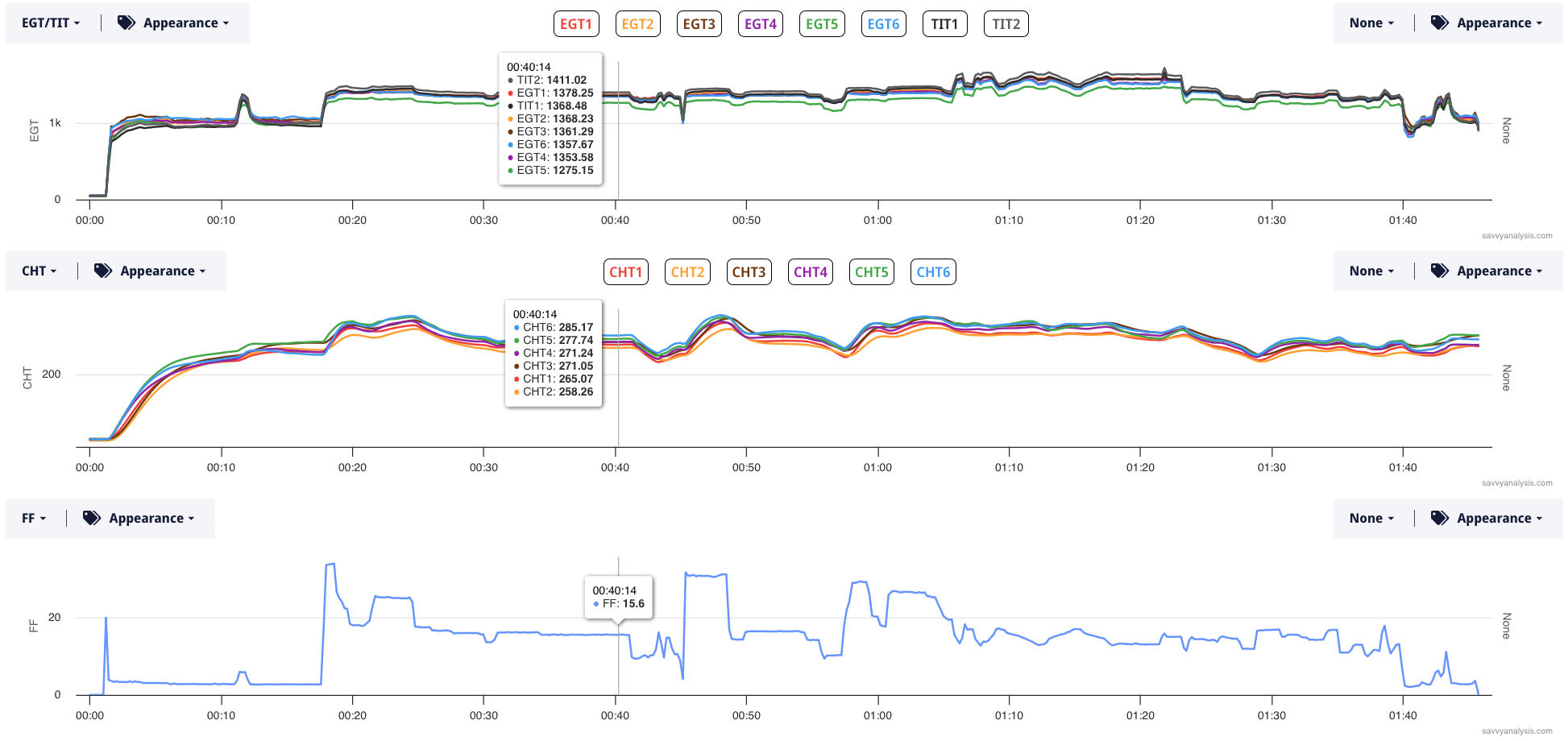
I put the cursor where it is so you could see that FF at 15.7 is not very lean, and CHTs are low – even for the remarkably efficient cooling on a Cirrus. The data was submitted with this report —
The right TiT is higher than the left by 75 degrees, when leaning I cant get the TiT under 1600 like I used to. This problem started after a the last annual, when the plane came out the TiTs were out of control…
The split TITs is not unusual on this engine, and it’s usually the right higher than the left. But the 75° comment and the “like I used to” comment seemed like clues. along with the problem beginning after an annual.
There’s a pretty big drop in EGTs at the 35 min mark. Let’s take a closer look at that.
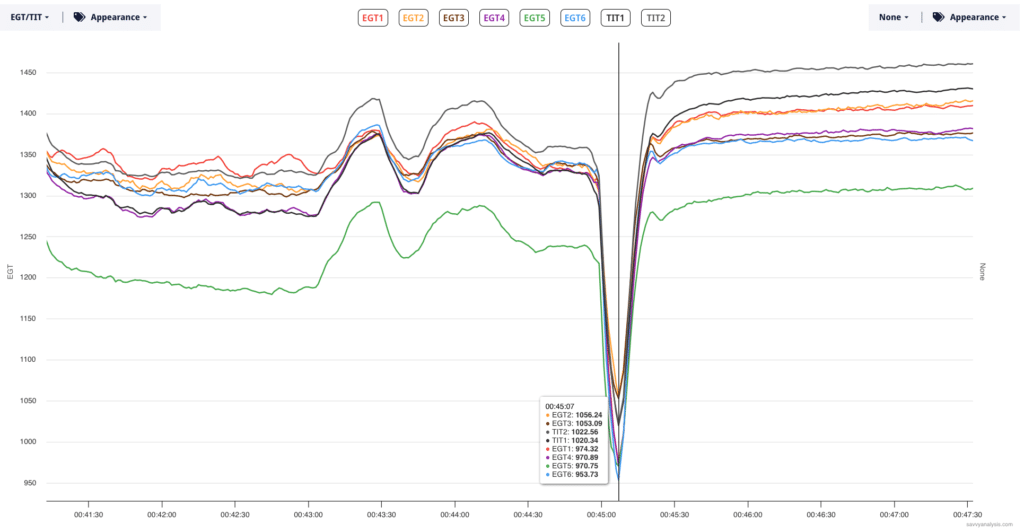
The client reported —
I switched to “L” and left it there for 30 seconds, then when back to “Both” then when I switched to “R” the engine quit….I immediately went back to “Both” and the engine ran fine. Surprised at this result I thought maybe I turned the key too far and went to the off position so I tried it again and had the exact same result with the engine quitting.
Sidebar – this seems like a good time for a remind about what to do if the engine quits during an inflight mag check. This is in the Savvy test profile.
If the engine quits while switching to single mag operation, pull the mixture to idle cut off, then switch to the other mag, then slowly advance the mixture until the engine restarts.
If you just switch back to BOTH you could get send a big surge through the exhaust system and now you’ve got another problem. Sidebar done.
Once you know there’s a dead right mag, the 75º rise and the low CHTs make sense. Why did the right mag fail right after the annual? Can’t connect the dots on that – might just be coincidence.
We’ll finish this month with a Lancair IV-P powered by a Continental TSIO-550 and data from a Garmin 3X with a 1 sec sample rate. EGTs, with CHTs and FF below. Nothing special about the cursor placement. Just wanted you to see the numbers in cruise. The issue is the CHT rise starting about 01:10 in the timeline.
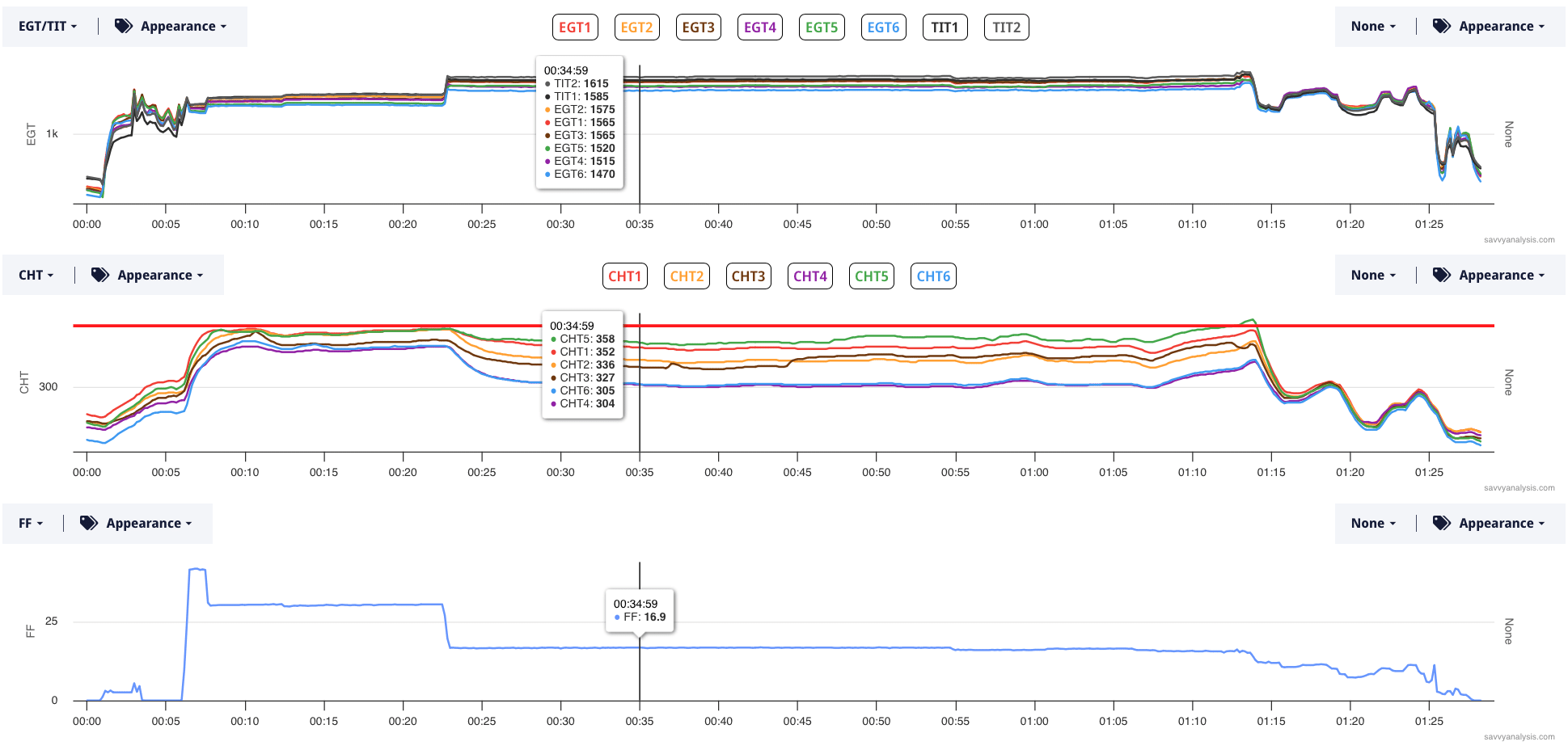
What are the questions a good puzzle-solver/analyst would ask? First big question is did something go wrong with the engine or is there other data that can explain the CHT rise? EGTs don’t move. FF doesn’t move until the rise has ended. MAP and RPMs aren’t displayed but they don’t move either. MAP is 28″ and RPMs are 2450.
The client mentioned this was during a descent to an airport with a 5,000 msl elevation. So here’s a display zoomed into the CHT rise, with CHTs, GPS ALT , and True Airspeed below.
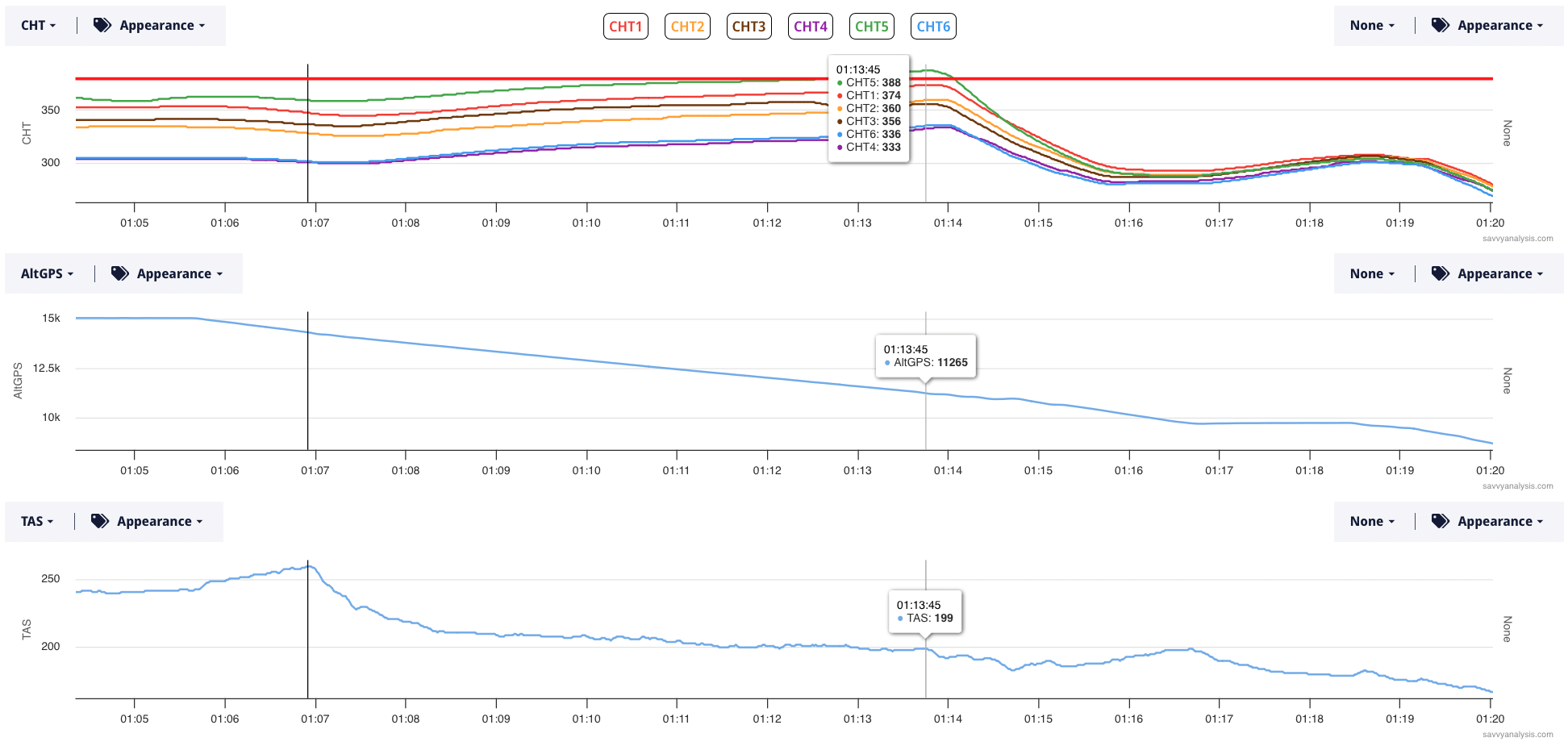
TAS peaks at 260 where the cursor line is at 01:07. Seven minutes later TAS is 199. I didn’t display OAT – it rises < 10º during the descent, so hard to hang a 50º rise in CHT on that. The big ∆ in the room is that 60 knots of ram air going away. It shows up in oil temp, too. No substitute for good cooling.
A lot of us flying behind less cooling-efficient aging aircraft powered by big-bore Continentals and Lycomings would be happy with a high CHT of 388º on a flight. I know I would.
If William of Occam were around I suspect he would, too.